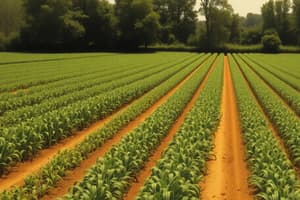Podcast
Questions and Answers
What is the primary purpose of crop rotation?
What is the primary purpose of crop rotation?
- To increase crop yields
- To improve soil fertility and reduce pests and diseases (correct)
- To control weeds
- To reduce pest and disease pressure
What is one of the benefits of crop rotation?
What is one of the benefits of crop rotation?
- Reduced crop yields
- Increased pest and disease pressure
- Improved soil fertility (correct)
- Increased use of pesticides
What is simple rotation?
What is simple rotation?
- Rotating crops continuously, without leaving the land fallow
- Rotating four or more crops in a specific order
- Rotating two or three crops in a specific order (correct)
- Rotating crops randomly, without a specific order
What is an example of a common crop rotation in the Midwest United States?
What is an example of a common crop rotation in the Midwest United States?
What is an important factor to consider when designing a crop rotation?
What is an important factor to consider when designing a crop rotation?
What is a benefit of the wheat-barley-canola rotation?
What is a benefit of the wheat-barley-canola rotation?
What is the purpose of continuous rotation?
What is the purpose of continuous rotation?
Why is crop selection important in crop rotation?
Why is crop selection important in crop rotation?
What is a common rotation in vegetable production?
What is a common rotation in vegetable production?
What is a benefit of crop rotation in regards to pests and diseases?
What is a benefit of crop rotation in regards to pests and diseases?
Flashcards are hidden until you start studying
Study Notes
Crop Rotation
Crop rotation is a technique used in agriculture to improve soil fertility, reduce pests and diseases, and increase crop yields.
Benefits of Crop Rotation:
- Improved soil fertility: Crop rotation helps to replenish soil nutrients, reducing the need for synthetic fertilizers.
- Reduced pest and disease pressure: Changing crops breaks the life cycle of pests and diseases, reducing the need for pesticides and fungicides.
- Increased crop yields: Crop rotation can lead to higher yields due to improved soil health and reduced pest and disease pressure.
- Weed control: Crop rotation can help to reduce weed populations by changing the environment and making it less conducive to weed growth.
Types of Crop Rotation:
- Simple rotation: Involves rotating two or three crops in a specific order.
- Complex rotation: Involves rotating four or more crops in a specific order.
- Continuous rotation: Involves rotating crops continuously, without leaving the land fallow.
Factors to Consider When Designing a Crop Rotation:
- Crop selection: Choose crops that have different growth habits, nutrient requirements, and pest susceptibility.
- Soil type: Consider the soil type and its limitations when designing a crop rotation.
- Climate: Consider the local climate and its impact on crop growth and pest pressure.
- Pest and disease management: Consider the pest and disease management requirements of each crop in the rotation.
Examples of Crop Rotations:
- Corn-soybean-wheat rotation: A common rotation in the Midwest United States, which helps to control pests and diseases, and improve soil fertility.
- Wheat-barley-canola rotation: A common rotation in Canada, which helps to control weeds and improve soil fertility.
- Tomato-pepper-cucumber rotation: A common rotation in vegetable production, which helps to control pests and diseases, and improve soil fertility.
Benefits of Crop Rotation
- Crop rotation improves soil fertility by replenishing nutrients, reducing the need for synthetic fertilizers.
- It reduces pest and disease pressure by breaking their life cycles, minimizing the need for pesticides and fungicides.
- Crop rotation leads to increased crop yields due to improved soil health and reduced pest and disease pressure.
- It helps control weeds by changing the environment, making it less conducive to weed growth.
Types of Crop Rotation
- Simple rotation involves rotating two or three crops in a specific order.
- Complex rotation involves rotating four or more crops in a specific order.
- Continuous rotation involves rotating crops continuously, without leaving the land fallow.
Factors to Consider in Crop Rotation Design
- Crop selection should consider different growth habits, nutrient requirements, and pest susceptibility.
- Soil type and its limitations should be considered when designing a crop rotation.
- Local climate and its impact on crop growth and pest pressure should be considered.
- Pest and disease management requirements of each crop in the rotation should be taken into account.
Examples of Crop Rotations
- Corn-soybean-wheat rotation is a common rotation in the Midwest United States, controlling pests and diseases, and improving soil fertility.
- Wheat-barley-canola rotation is a common rotation in Canada, controlling weeds and improving soil fertility.
- Tomato-pepper-cucumber rotation is a common rotation in vegetable production, controlling pests and diseases, and improving soil fertility.
Studying That Suits You
Use AI to generate personalized quizzes and flashcards to suit your learning preferences.




